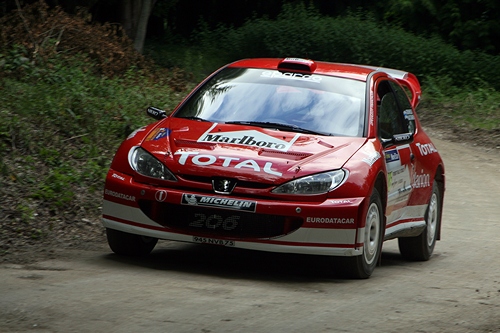Background
Before the 206WRC ever hit a competitive stage expectations for it were high, based upon the record of its predecessor the all conquering 205T16.
The 206WRC debuted in 1999 on the Tour de Corse. The 206WRC used a transversely mounted engine mated to longitudinal gearbox a layout shared by the Ford Focus and one that allows almost perfect weight distribution and better serviceability but also makes power transfer from engine to transmission more complex, involving more gears than in a traditional layout. Indeed, gearbox failures were the single most common problem for early 206WRCs.
The 2000 season saw the arrival of the Evo1, whilst the changes to the outward appearance were none, under the skin it was a whole different story. A new turbo and a redesigned inlet manifold saw the rev band increased enabling more power to be produced at lower revs. Changes to the drive train saw the original car’s mechanical rear differential dropped in favour of active differentials all around and additional hydraulic work to the four-wheel drive improved reliability.
The 2001 season saw the arrival of the Evo2, perhaps the most striking new feature was five-speed gearbox. Over the years the number of gears in rally cars had steadily increased so Peugeot's decision to drop down a gear was surprising. The theory behind the decision was two-fold, firstly reliability, less gears meant Peugeot could house bigger and hence stronger gears in same space and secondly the changes made in the Evo1 model meant that less gears were required because of the increase in torque and wider usable rev band. Other changes concentrated on serviceability, reliability and weight loss. Under bonnet air circulation was improved in order to help engine and component cooling, resulting in visually different bonnet. Also certain components were made more accessible to facilitate easy servicing.
The 2002 season saw the arrival of the Evo3, in this final version of the 206WRC, Peugeot Sport concentrated mostly on details, with the rear wing of the car having vertical fins added to keep it generating down force even while the car was sliding sideways, and continuing to improve reliability through further improvements to the cooling and strengthening of the suspension.
This Car
Is a genuine ex works car and is chassis number 43. It competed in both factory team colours originally silver in EVO 2 spec before being changing to red when it was upgraded to EVO 3 spec.
Technical
Engine : Four-cylinder, 2ltr, twin cam, 16 valve, in-line transversally mounted in the front of the car, 300 bhp
Induction : Fuel Injected, Turbocharged

